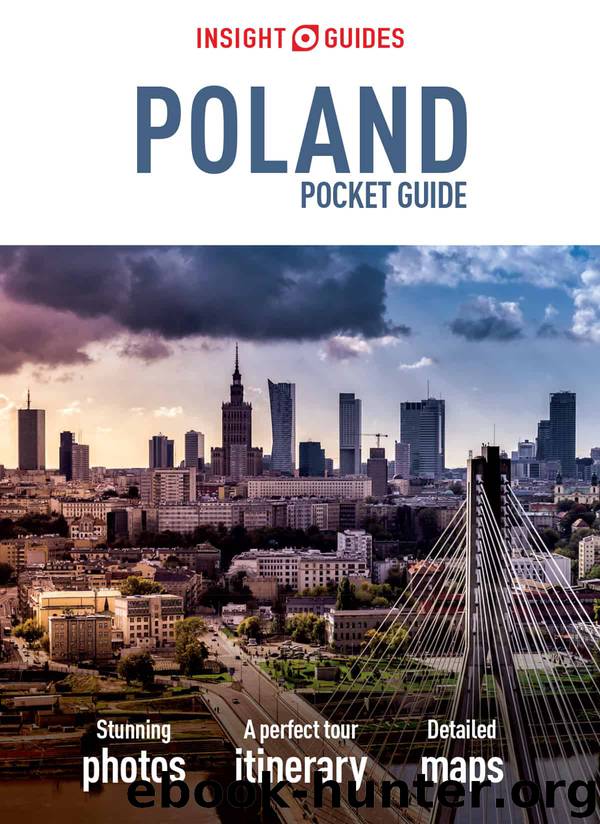Insight Guide: Pocket Poland (Insight Pocket Guides) by Guides Insight

Author:Guides, Insight [Guides, Insight]
Language: eng
Format: epub
Publisher: APA
Published: 2016-04-18T04:00:00+00:00
Old Town
The Old Town (Stare Miasto) developed in tandem with the Main Town, though it was never as wealthy and after the war was not as lovingly or thoroughly rebuilt. Consequently, it has fewer sights of interest, but enough for a half-day’s exploration.
Of principal interest is the Great Mill (Wielki Młyn; ul. Wielkie Młyny 16), a terrific structure with a sloping tiled roof. Built by the Teutonic Knights in 1350, the mill was the largest in medieval Europe, and it continued to function until the end of World War II. Today, however, it is an indoor shopping mall with all manner of clothing stores. Past the small pond behind the mill and across the street is Gdańsk’s Old Town Hall (Ratusz Starego Miasta; ul. Korzenna 33–5; daily 10am–6pm), a 16th-century building that was labelled the pearl of the Dutch Renaissance. Designed by Antoon van Opberghen, who also designed the Great Armoury, this is where the town council met. It now contains a café and exhibition centre, but of greatest interest is the rich interior. Walk in and take a look upstairs, where you’ll find the Great Hall.
Directly across the street from the Great Mill is St Catherine’s Church (Kościół Św. Katarzyny; ul. Profesorska 3), the former parish church and the oldest church in Gdańsk, begun in 1220. The Gothic-vaulted interior is most celebrated for the enormous mural, on the left aisle beneath the organ loft, depicting Christ’s entry into Jerusalem. The church tower holds a 37-bell carillon that chimes on the hour and you can visit the interesting Tower Clock Museum (Mon–Wed and Fri–Sun 11am–7pm, Thu 10am–3pm; www.mhmg.pl )
Directly behind, or east of, St Catherine’s is St Bridget’s Church (Kościół Św. Brygidy; ul. Profesorska 17), which dates from the 15th century and later became a refuge for the Solidarity movement from the Communist government. Inside are several permanent displays related to the human rights struggles of the Polish workers’ union. In fact, Lech Wałęsa attended Mass here before he became the spokesman for Solidarność. The politicised nature of the church is evident on the right aisle in a series of crosses from the 1980s strikes, the gravestone of murdered priest (and Solidarność sympathizer) Jerzy Popiełuszko, and a bas-relief history of the workers’ union.
Download
This site does not store any files on its server. We only index and link to content provided by other sites. Please contact the content providers to delete copyright contents if any and email us, we'll remove relevant links or contents immediately.
China Rich Girlfriend by Kwan Kevin(4298)
The Silk Roads by Peter Frankopan(4275)
Annapurna by Maurice Herzog(3302)
Full Circle by Michael Palin(3273)
Hot Thai Kitchen by Pailin Chongchitnant(3220)
Okonomiyaki: Japanese Comfort Food by Saito Yoshio(2629)
The Ogre by Doug Scott(2507)
City of Djinns: a year in Delhi by William Dalrymple(2438)
Photographic Guide to the Birds of Indonesia by Strange Morten;(2412)
Vietnam, Cambodia, Laos & Northern Thailand by Lonely Planet(2321)
Tokyo by Rob Goss(2295)
Tokyo Geek's Guide: Manga, Anime, Gaming, Cosplay, Toys, Idols & More - The Ultimate Guide to Japan's Otaku Culture by Simone Gianni(2244)
Everest the Cruel Way by Joe Tasker(2135)
Discover China Travel Guide by Lonely Planet(2121)
Iranian Rappers And Persian Porn by Maslin Jamie(2102)
China (Lonely Planet, 11th Edition)(2037)
Lonely Planet China(2032)
China Travel Guide by Lonely Planet(1995)
Top 10 Dubai and Abu Dhabi by DK Travel(1994)
